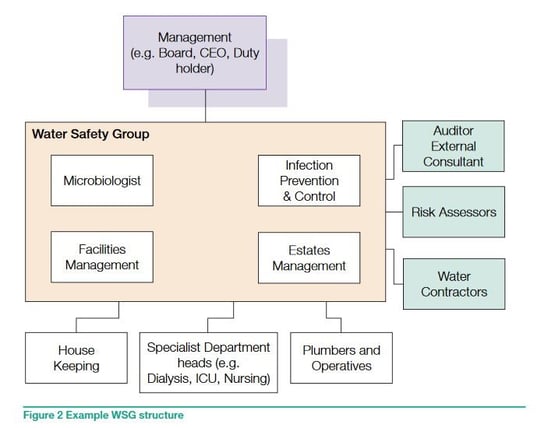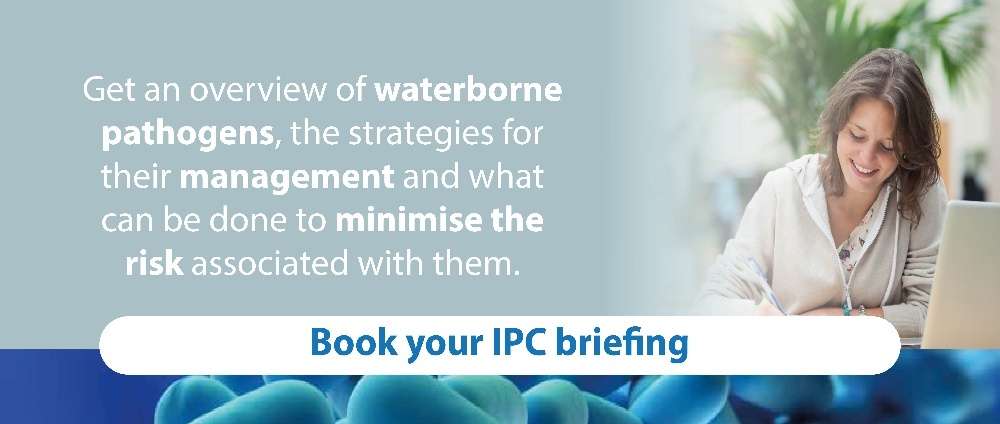The Need for Appropriate Training
Infection Prevention and Control [IPC] staff have an increasingly key-role to play in today’s water safety management approach within Healthcare property environments.
Even before the 2006 publication of HTM04-01 that highlighted:
"The infection control officer, or consultant microbiologist if not the same person, is the person nominated by management to advise on infection control policy and to have responsibility for the maintenance of water quality.”
…it was apparent many healthcare frameworks did not adequately consider or include all the clinical implications of the typical risk minimisation measures undertaken to resolve their water safety issues.
Indeed, although the association of ‘maintenance’ and ‘water quality’ with IPC in the aforementioned guidance sentence did not sit well with some staff, this HTM did make clear IPC staff were a critical part of any Water Safety Group [WSG] framework.
So, whilst the increasing involvement of IPC in water hygiene management can only be of benefit, appropriate training is also a necessity to break the disconnect between Estates operational staff and clinically based departmental staff.
Water Hygiene Guidance - ACOP L8
The HSE’s ACOP L8 [4th ed. (2013)] makes clear within its guidance section:
“Inadequate management, lack of training and poor communication are all contributory factors in outbreaks of legionnaires’ disease. It is therefore important that the people involved in assessing risk and applying precautions are competent, trained and aware of their responsibilities.”
The HSE has also published technical guidance known as HSG274. This provides ‘practical advice on the legal requirements’ of the above legislation concerning the risk from exposure to legionella, and guidance on compliance with the relevant parts of the Management of Health and Safety at Work Regulations (1999).
COSHH and the Management of Health Safety at Work Regulations both identify a requirement to undertake Legionella risk assessments and highlight the importance, as far as reasonably practicable, of preventing or, where prevention is not possible, controlling risks.
Another common theme of the Regulations is the need for suitable information, instruction and water hygiene training to be provided for all staff on the risks and the control measures to be put in place for example a Legionella awareness course online
Organisations should also keep records of all water safety training received, regularly review training needs, and provide regular refresher training.
The sum of which amounts to Legionnaires’ disease being a foreseeable risk that, following a predefined management process, can be minimised by implementing a scheme of control measures that is effective and reasonable, i.e. without undue cost when compared to the nature of the risk. A lack of knowledge is not considered a reasonable legal defence when serious illness and/or fatalities occur because of poorly managed building water systems.
“Training is an essential element of an employee’s capability to carry out work safely”.
HSE Approved Code of Practice L8 (2013).
IPC and your Water Safety Group (WSG)
The current Department of Health HTM04-01 Part B, chapter on operational management identifies that:
“The aim of the WSG is to ensure the safety of all water used by patients, residents, staff and visitors, to minimise the risk of infection associated with waterborne pathogens. It provides a forum in which people with a range of competencies can be brought together to share responsibility and take collective ownership for ensuring it identifies water-related hazards, assesses risks, identifies and monitors control measures and develops incident protocols.”
It goes on to say:
“This would normally involve representation from estates (operations and projects), an Authorising Engineer [Water]/independent adviser and infection control, medical microbiology, nursing, augmented care and other dept.’s of importance, i.e. including an appropriate clinical presence.”
Indeed, in the below flow chart [Figure 2 Example WSG structure] an example of a Water Safety Group structure put’s Infection Prevention and Control and the Microbiologist at the heart of the group. Although there are several key remit items for any WSG, they specifically include amongst others:
- To determine the particular vulnerabilities of the at-risk population;
- To ensure surveillance and review of clinical and environmental monitoring data;
- To be responsible for water hygiene training and communication on water-related issues, and crucially;
- To work with and support the IPC team.

Water Safety Training
Critically, HTM04-01 also states:
“The WSG should implement a programme of staff training to ensure that those appointed to devise strategies, carry out control measures and undertake associated monitoring are appropriately informed, instructed and trained. They should also be assessed as to their competency. It is also essential that they have an overall appreciation of the practices affecting water hygiene and safety, and that they can interpret the available guidance and perform their tasks in a safe and technically competent manner.”
Whilst specific training criteria for IPC staff is not detailed in HTM guidance, under the water hygiene training banner generally, it does state:
“Individuals to whom tasks have been allocated (supervisors and managers as well as operatives) need to have received adequate training in respect of water hygiene and microbiological control appropriate to the task they are responsible for conducting.”
It goes on, to say:
“The WSG should also ensure that IPC teams have received adequate training and that there is compliance with national evidence-based guidelines for preventing healthcare-associated infections.”
To this end, the training must be pertinent to the individual organisation and their internal policies and procedures in place [including standard Estates operational approaches to routine monitoring and critically to resolving non-compliances], whilst providing a grounding in the fundamental issues underpinning the successful management of Legionella, Pseudomonas aeruginosa or other water borne pathogens.
HTM04-01 provides a good basis for the generic topics required for inclusion in water hygiene training and these incorporate the following all of which are of direct benefit to IPC staff:
- Organisational governance arrangements in relation to water hygiene and safety;
- Familiarisation with local policies/procedures in relation to the management and provision of water hygiene and safety;
- Information on prominent waterborne pathogens and their consequences;
- The ways in which water distribution systems, water outlets, components and any associated equipment can become contaminated;
- The responsibilities of individuals to prevent the contamination of the water distribution system and water outlets and assisting in ensuring control measures in place are effective;
- How the safety of water can be maintained by good hygiene practices;
- System design;
- Components/accessories (taps, TMVs);
- Organisation-specific control measures;
- The impact of getting it wrong;
- Role of persons being trained;
- Personal hygiene.
Whilst the above list is not exhaustive, having accepted IPC staff as valued and key members of any Healthcare organisation’s WSG, this degree of suitable training should ensure they are well versed with all current legislation guidance and local policies and in doing so they will then be able to minimise the risk to patients and service-users, especially those treated in augmented care settings.
Learn more by reading “The importance of legionella training” with everything you need to know about what training you need and how to do it >
Feel free to reach out if you have any questions about the issues mentioned above or if you would like to consult with one of our experts on water hygiene.
Editor’s Note: The information provided in this blog is correct at date of original publication – November 2020.
© Water Hygiene Centre 2020









